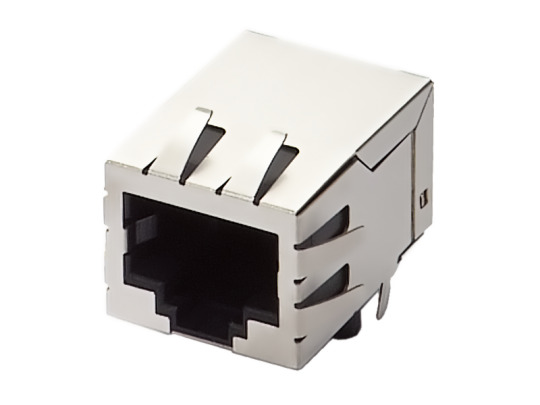#Modular telephone jack
Explore tagged Tumblr posts
Text
https://www.futureelectronics.com/p/interconnect--modular-ethernet-connectors--modular-jacks/5569381-1-te-connectivity-2140444
Modular telephone jack, telephone jacks, Applications for Modular Jacks
8 Position 2x1 Right Angle Through Hole Stacked RJ45 Modular Jack
#TE Connectivity#5569381-1#Connector#Modular/Ethernet Connector#Modular Jacks#Modular telephone jack#Applications#phone jack#keystone jack#Telephone applications#Ethernet jacks#Cat 5e jacks#modular jack connector#Types of Modular Jacks
1 note
·
View note
Text
Applications for Modular Jacks, Telephone applications, RS-232 serial interfaces
6 Position Single Port Straight Through Hole RJ25 Modular Jack
0 notes
Text
https://www.futureelectronics.com/p/interconnect--modular-ethernet-connectors--modular-jacks/5569381-1-te-connectivity-2896884
Modular plug connectors, what is a modular jack, Ethernet jacks, Networking,
8 Position 2x1 Right Angle Through Hole Stacked RJ45 Modular Jack
#Connector#Modular/Ethernet Connector#Modular Jacks#5569381-1#TE Connectivity#modular plug connectors#Ethernet jacks#Networking#Header plug#Applications#RS-232 serial interfaces#keystone jack#board mount connector#Telephone#keystone
1 note
·
View note
Text
Telephone modular
I like reading about Microcontrollers, 32 bit, STM32F105VCT6, STMicroelectronics, Ethernet jacks and Telephone modular
0 notes
Text
Price: [price_with_discount] (as of [price_update_date] - Details) [ad_1] Description: 3.5mm Female Audio socket to RJ9 Male Modular Plug Adapter Cable Headset Headphone Adapter.Fit for a great majority of analog headphone,such for Avaya 1612,9600, SNOM Yealink Phones.Get this headset adaptor them you can use your favorite computer analog headphone to chat on telephone.Connector A: 2x 3.5mm female ,Connector B: RJ9 male; Length:25cm.2 slots -one for micophone and one for headset. Package Includes: 1 Piece Dual 3.5mm Jack to RJ9 Plug Adapter. 3.5Mm Female Audio Socket To Rj9 Male Modular Plug Adapter Cable Headset Headphone Adapter. Fit For A Great Majority Of Analog Headphone,Such For Avaya 1612,9600, Snom Yealink Phones. Get This Headset Adaptor Them You Can Use Your Favorite Computer Analog Headphone To Chat On Telephone. Connector A: 2X 3.5Mm Female ,Connector B: Rj9 Male; Length:25Cm.2 Slots -One For Micophone And One For Headset. Package Includes: 1 Piece Dual 3.5Mm Jack To Rj9 Plug Adapter. [ad_2]
0 notes
Text
Connecting the Dots: Exploring the Types of Wire Connectors in Electronics
Wire connectors play a crucial role in the world of electronics, facilitating secure and reliable connections between wires and components. With a variety of types available, each designed for specific purposes, understanding the different wire connectors is essential for efficient electronic assembly and maintenance. Let's delve into the various types of wire connectors in electronics and their unique characteristics.
1. Crimp Connectors
Crimp connectors are widely used in electronics for creating permanent electrical connections. They consist of a metal sleeve that is crimped onto a wire using a specialized tool, creating a strong and secure bond. Crimp connectors come in various types, including ring terminals, spade terminals, butt connectors, and quick-connect terminals, each suited for different wire gauges and applications.
2. Screw Terminals
Screw terminals are another common type of wire connector used in electronics. They feature a screw mechanism that clamps down on stripped wire ends, creating a reliable electrical connection. Screw terminals are often found in terminal blocks, electrical switches, and power distribution panels, providing a convenient and adjustable way to connect and disconnect wires.
3. Wire Nuts
Wire nuts, also known as twist-on connectors, are used to join multiple wires together securely. They feature a threaded cap that twists onto the stripped ends of wires, creating a tight and insulated connection. Wire nuts are commonly used in residential and commercial electrical wiring for connecting wires within junction boxes, light fixtures, and electrical outlets.
4. Push-In Connectors
Push-in connectors, also referred to as push-in wire connectors or push-in terminals, offer a quick and tool-free way to connect wires. These connectors feature spring-loaded slots where stripped wire ends can be inserted, creating a secure connection without the need for twisting or crimping. Push-in connectors are often used in lighting fixtures, switches, and electrical appliances for easy installation and maintenance.
5. Terminal Blocks
Terminal blocks are modular connectors that provide a convenient way to connect multiple wires or components. They consist of insulated blocks with metal terminals or screws where wires can be attached. Terminal blocks come in various configurations, including barrier strips, DIN rail-mounted blocks, and PCB-mounted blocks, making them versatile for different electronic applications.
6. D-sub Connectors
D-sub connectors, named for their D-shaped metal shell, are commonly used for data and signal connections in electronics. They feature multiple pins arranged in rows, with different configurations such as DB9, DB15, and DB25. D-sub connectors are used in computer peripherals, audio/video equipment, and industrial automation systems for reliable data transmission.
7. JST Connectors
JST connectors, manufactured by Japan Solderless Terminal (JST) Corporation, are compact and reliable connectors commonly used in electronic devices and appliances. They come in various series and styles, including wire-to-board connectors, wire-to-wire connectors, and board-to-board connectors. JST connectors are known for their low profile, high current capacity, and secure locking mechanisms.
8. RJ Connectors
RJ connectors, short for Registered Jack connectors, are widely used in telecommunications and networking applications. They include RJ45 connectors for Ethernet connections, RJ11 connectors for telephone lines, and RJ12 connectors for data transmission. RJ connectors feature multiple contacts that align with corresponding pins in jacks or sockets, providing a standardized and reliable interface for data and voice communication.
Conclusion
The types of wire connectors in electronics are diverse and specialized, each serving a specific purpose in creating and maintaining electrical connections. From crimp connectors for secure terminations to push-in connectors for easy installations, the variety of connectors available allows for efficient and reliable electronic assembly. Understanding the characteristics and applications of these connectors is essential for electronics engineers, technicians, and hobbyists to ensure proper connectivity and functionality in electronic devices and systems.
0 notes
Link
0 notes
Text
Ophelia By the Yard
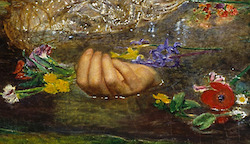
Cobwebbed passages and wax-encrusted candelabra, dungeons festooned with wrist manacles, an iron maiden in every niche, carpets of dry ice fog, dead twig forests, painted hilltop castles, secret doorways through fireplaces or behind beds (both portals of hot passion), crypts, gloomy servants, cracking thunder and flashes of lightning, inexplicably tinted light sources, candles impossibly casting their own shadows, rubber bats on wires, grand staircases, long dining tables, huge doors with prodigiously pendulous knockers to rival anything in Hollywood.
Here was the precise moment — and it was nothing if not inevitable — when the darkness of horror film, both visible and inherent, leapt from the gothic toy box now joined by a no less disconcerting array of color. The best, brightest, sweetest, and most dazzling red-blooded palette that journeyman Italian cinematographers could coax from those tired cameras. Color, both its commercial necessity as well as all it promised the eye, would hereafter re-imagine the genre’s possibilities, in Italy and, gradually, everywhere else.
When color hit the Italian Gothic cycle, a truly new vision was born. In Hammer films and other UK horror productions, the cheapness of Eastmancolor made it possible for blood to be red. Indeed, very red. And, while we shouldn't underestimate the startling impact this had, it was a fairly literal use of the medium. In the Italian movies, and to a large extent in Roger Corman's Poe cycle, color was an unlikely vehicle to further dismantle realism rather than to assert it. Overrun with tinted lights and filters, none of which added to the film’s realistic qualities, the movies became delirious. In Corman's Masque of the Red Death, we learn of an experiment that uses color to drive a man insane; it seems that filmmakers like Corman and Mario Bava were attempting the very same trick on their audiences.
The application of candy-wrapper hues to a haunted castle flick like The Whip and the Body adds a pop art vibe at odds with the genre, and when you get to something like Kill, Baby...Kill! the Gothic trappings are barely able to mask a distinctly modern sensibility, so much so that Fellini could plunder its phantasmal elements for Toby Dammit, fitting them perfectly into his sixties Roman nightmare.
Blood and Black Lace brings the saturated lighting and Gothic fillips into the twentieth century -- a sign creaking in a gale is the first image, translated from Frankensteinland to the exterior of a contemporary fashion house. A literal faceless killer disposes of six women in diabolical ways. The sour-faced detective remains several deaths back on the killer’s trail because the movie knows its audience, knows that it has zero interest in detection, character, motivation — though it’s all inertly there as a pretext for sadism, set-pieces of partially-clad women being hacked up, dot the film like musical numbers or action sequences might appear in a different genre.
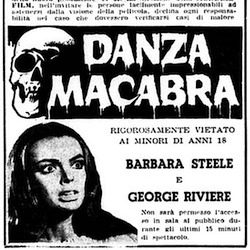
Since the 19th-century audience for literary Gothic Horror was comprised of far fewer men than women, would it be fair to ask whether Giallo’s advent might be an instrument of brutal violence, even revenge against “feminine” preoccupations? Consider 1964’s Danza Macabra, the film’s amorous vibes finding their ultimate source in that deathless screen goddess named Barbara Steele, whose marble white flesh photographs like some monument to classicism startled into unwanted Keatsian fever. Her presence practically demands that we ask ourselves: “Who is this wraith howling at a paper moon?” In other words, is it a coincidence that Steele’s “Elizabeth Blackwood” — a revenant temptress and undead sex symbol — hits screens the very same year as Giallo, which would transform Italian cinema into a decades-long death mill for women?
The name “giallo”, meaning yellow, derives from the crime paperbacks issued by Italian publisher Mondadori. The eye-catching covers, featuring a circular illustration of some act of infamy embedded in a yellow panel, became utterly associated with the genre of literature. These books were likely to be by Edgar Wallace, the most popular author in the western world, or Agatha Christie: cardboard characters sliding through the most mechanical of plots; or classier local equivalents, like Francesco Mastriani or Carolina Invernizio. The founding principles laid down concerned the elaborate deceptions concealed by their authors, traps for the unwary reader, and the use of a distinctive design motif. The tendency of the characterisation to lapse into sub-comic-book cliché, the figures incapable of expressing or inspiring real sympathy, was, perhaps, an unintended side-effect of the focus on narrative sleight-of-hand.
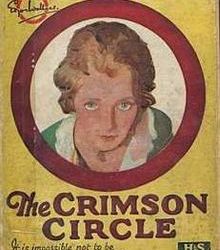
When Italian filmmakers sought to translate sensational literature to the screen, they looked to other filmic influences: American film noir, influenced by German expressionism and often made by German emigrés (Lang, Siodmak, Dieterle, Ulmer); and the popular krimi cycle being produced in West Germany, mostly based on Edgar Wallace's leaden "shockers." These deployed stock characters, bizarre methods of murder, deceptive plotting, and exuberant use of chiaroscuro, the stylistic palette of noir intensified by more fog, more shafts of light, more inky shadows. A certain amount of fun, but different from the coming bloodbath because Wallace, despite somewhat fascistic tendencies, is anodyne and anaemic by comparison. No open misogyny, a sadism sublimated in story, a touching faith in Scotland Yard and the class system. In the Giallo, Wallace's more sensational aspects are adopted but made to serve a sensibility quite alien to the stodgy Englander: people are generally rotten, the system stinks, and crime becomes a lurid spectator sport served up to a viewer both thrilled and appalled.
The Giallo fetishizes murder. But then, it fetishizes everything in sight. Every object, every half-filled wine glass and pastel-colored telephone, is photographed with obsessive, product-shot enthusiasm. Here, it must be emphasized that design implicates the viewer as the Italian camera-eye gawps like some unabashed tourist. Knife, wallpaper, onyx pinky ring — each detail transforms into an object made eerily subject: a sentient and glowering fragment of our own conscience, staring back at us in the darkened theater and pronouncing ineluctable guilt. And yet, for the directors who rode most dexterously the Giallo wave, homicide was something one did to women. Indulging in equal-opportunity lechery was merely an excuse to find other, more violent outlets for their misogyny. Please enter into evidence the demented enthusiasm for woman-killing evinced by Dario Argento, Mario Bava, Lucio Fulci, et al. — whatever trifling token massacres of men one might exhume from their respective oeuvres are inconsequential. Argento’s defense, “I love women, so I would rather see a beautiful woman killed than an ugly man,” should not satisfy us, and hardly seems designed to (also bear in mind Poe’s assertion that the death of a beautiful young woman was the most poetic of all subjects).
Filmmakers like Argento have no interest in sex per se. Suffering seems inessential, but terror and death are key, photographed with the same clinical absorption and aesthetic gloss as Giallo-maestros habitually apply to their interior design. Here, it must be emphasized that design implicates the viewer as the Italian camera-eye gawps like some unabashed tourist. Knife, wallpaper, onyx pinky ring – each detail transforms into an object made eerily subject: a sentient and glowering fragment of our own conscience, staring back at us in the darkened theater and pronouncing ineluctable guilt. That’s one important subtlety often lost amid Giallo’s vast antisocial hemorrhage.
Like a river of blood, homophobia, in the literal meaning of fear rather than hatred, runs through the genre. Lesbians are sinister and gay men barely exist. As we try to work out what in hell the Giallo is really up to, little dabs of dime-store Freudianism seem sufficient.
The filmmakers’ misogyny could be suspect, a sign of compromised masculinity, so they need fictional avatars to cloak their own feverish woman-hating. The subterfuge is clumsy at best, the desultory deceit embarrassingly macho. Giallo’s visual force, powerful enough to divorce eye from mind, is another matter, leaving us demoralized and ethically destitute; our hearts beating with all the righteous indignation of three dead shrubs (and maybe a half-eaten sandwich).
The Giallo is founded on an unstated assumption: the modern world brings forth monsters. Jack the Ripper was an aberration in his day, but now there's a Jack around every corner, behind every piece of modular furniture, every diving helmet lamp. Previously, disturbing events arose from what Ambrose Bierce called The Suitable Surroundings, or what the mad architect in Fritz Lang's The Secret Beyond the Door termed, with sly and sinister euphemism, "propitious rooms." There's the glorious line in Withnail and I: "That's the sort of window faces appear at." But now, in the modern world, evil occurs in the nicest of places, and tonal consistency died in a welter of cheerful stage blood. One needn’t enter an especially Bad Place to meet one’s worst nightmare, or perhaps better to say: the whole bright world qualified as a properly bad place. Imagine the pages of an interior design magazine invaded by anonymous psychopaths intent on painting the gleaming walls red.
Though the victims are overwhelmingly female and their killers male (Argento typically photographed his own leather-gloved hands to stand in for his assassin’s), when the violence becomes over-the-top in its sexualized woman-hating (like the crotch-stabbing in What Have You Done to Solange?), it’s usually a clue that the movie’s murderer will turn out to be female: a simple case of projection. Only Lucio Fulci, the most twisted of the bunch, trained as a doctor and experienced as an art critic, not only assigns misogyny to a straight male killer (The New York Ripper) but plays the killer himself in A Cat in the Brain. Though, in another self-protecting twist of narrative, all psychological explanations in Gialli are bullshit, always. Criminology and clinical psychology are largely ignored, and Argento has a clear preference for outdated theories like the extra chromosome signaling psychopathy (Cat O’Nine Tails). Did anybody use phrenology, or Lombroso’s crackpot physiognomic theories, as plot device?

A tradition of the Giallo is that the characters all tend to be dislikable, something Argento at least resisted in Cat O’ Nine Tails and Deep Red. With disposable characters, each of whom might be the killer and each of whose violent demise is served up as a set-piece, this distancing and contempt might just be a byproduct of the form rather than a principle or ethos, but it’s of some interest, perhaps mitigating the misogyny with a wash of misanthropy. A Unified Field Theory of Gialli would find a more deep-seated reason for the obnoxious characters as well as the stylized snuff and the glamorous presentation. What urge is being satisfied, and why here, now, like this?
Class war? Though prostitute-ripping is encouraged in the Giallo, most victims are wealthy, slashed to ribbons amid opulent interiors. Urbane characters who might previously have graced the sleek “white telephone” films of forties Italian cinema were briefly edged out by neo-realism’s concentration on the working class. Now these exquisite mannequins are trundled back onscreen to be ritually slaughtered for our viewing pleasure.
Victims must always be enviable: either beautiful and sexy or rich and swellegant, or all of the above, so the average moviegoer can rejoice in their dismemberment with a clear conscience. Mario Bava bloodily birthed the genre in Blood and Black Lace (1964), brutally offing fashion models in a variety of Sade-approved ways, the killer a literally faceless assassin into whom the (presumed male) audience could pour their own animosities without ever admitting it, with the female killer finally unmasked to provide exculpatory relief.
If narrative formulas absolve the straight male viewer, compositions have a way of ensnaring him. Beyond that omnivorous indulgence of sensation for its own lurid sake one finds in Giallo, there is a more gilded emphasis placed on Beauty (in the Catholic sense), and it is only the women who are mounted upon its pedestal. That these avatars of beauty are to be savored, ravaged, and brutalized — in that order — is what concerns us. But the sex and the suffering that captivates most sadists is never what registers; no, it is the instance of death, the terror that afflicts the dying woman’s face that resonates. Once again, physical interiors become a negative form of emotional interiority, rooms amplified for the sole purpose of grisly annihilations; a kind of heretical, strictly anti-Catholic transcendence through amoral delight in what otherwise falls under trivial headings, either “the visuals” or “color palette” – neither of which touch the essential nerve endings of Giallo.
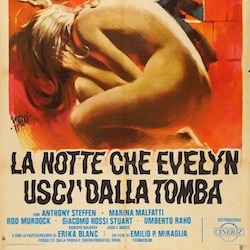
Swaddled inside an otherwise hyper-masculine castle lies a windowless chamber with feminine, if not psychotic, decor. Before he tortures and stabs her to death, “Lord Alan Cunningham” (fresh from his sojourn in the asylum) brings his first victim to this pageant of off-gassing plastic furniture, the single most obnoxious vision ever imposed on gothic environs. Risibly overblown ’70s chic rules The Night Evelyn Came Out of the Grave with nods to Edgar Allan Poe, as the modish Lord juggles sports cars and medieval persecution. Laughs escape the viewer’s throat in dry heaves when each new MacGuffin devours itself without warning. Take “Aunt Agatha” (easily two decades younger than her middle-aged nephews) suddenly rising from her motorized wheelchair, clobbered from behind seconds later, her body dragged into a cage where foxes promptly munch her entrails. Nothing comes of this. The phony paralysis, the aunt’s role in a half-dozen mysteries, which include a battalion of sexy maids in miniskirts and blonde Harpo Marx wigs – all gulped, swallowed.
About the only thing we know for certain is that “Aunt Agatha” is gorgeous. Though, in the end, she’s another casualty of the same nihilism that crashes Giallo aesthetics headlong into Poe country. That is into “Lord Alan” and his gaudy room crowded with designer goods to be catalogued in a horror vacui of visual intrusiveness – a trashy shrine to his late wife, the titular Evelyn. If lapses of good taste define The Night Evelyn Came Out of the Grave, they also reflect Giallo’s abiding obsession with real estate. After all, this Mod hypnagogia has to fill the eye somewhere. Why not bang in the middle of a castle? Poe’s The Fall of the House of Usher features a wealthy aristocrat burying his twin sister alive, thereby entombing his own femininity.
Evelyn represents both Usher’s primary theme of the divided self and the obdurate refusal to learn from it. “Alan,” who emerges a moral hero in the end (after his shrink aids and abets his murder spree), remains just as ornery, alienated, and vainglorious as Giallo itself. We’re never told precisely what the film’s fetish objects are supposed to mean. And since the camera seizes upon each one with existential grimness, we’re left with a visual style that begs its own questions.
Function follows form into the abyss. One Ophelia after another dies to satisfy our cruel delectation, even as will-o’-the-wisp light, taken from the bogs and neglected cemeteries of Gothic Horror, finds itself transformed into a crimson-dripping stiletto. Evelyn stands in for all Gialli, a genre which redefines film itself on the narrow front of visual impact: stainless steel cutlery and candy-colored light enact a sentient agenda as color becomes an instrument of hyperbolic misogyny that fills the eye and then some.
As with certain other Italian genres, notably the peplum, smart characterization, solid performances and decent dialogue seem not only unnecessary to the Giallo but unwelcome (the spaghetti western, conversely, in which many of the same directors dabbled, seemed to demand a steady stream of good, cold-blooded wise-cracks). Argento, in pursuit of that “non-Cartesian” quality he admired in Poe, took this to extremes, stringing non-sequiturs together to form absurdist cut-ups, torching his stars’ credibility merely by forcing them to utter such nonsense. And this wasn’t enough: from Suspiria (1977) on, the psychological thriller (which the Giallo is a sub-genre of, only the psychology has to be deliberately nonsensical) was increasingly replaced by the supernatural. So that the laws of nature could be suspended along with the laws of coherent motivation.
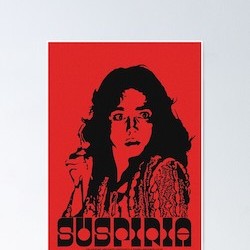
In Suspiria and its 1980 quasi-sequel Inferno, the traditional knifings are interspersed with more uncanny events, as when a stone eagle comes to life and somehow makes a seeing-eye dog kill his owner, and there are also grotesque incidents with no relation to story whatever: a shower of maggots, or an attack by voracious rats in Central Park. The Giallo’s quest for a solution, inspired as it was by the old-school whodunits, is all but abandoned, replaced by the search for the next sensational set-piece.
Argento’s villains are now witches, but, abandoning centuries of tradition, these witches show more interest in stabbing their fellow women with kitchen knives than with worshipping Satan or riding broomsticks. Regardless of who they’re meant to be, Argento’s characters must express his desires, enact the atrocities he dreams of. And inhabit places built for his aesthetic pleasure rather than their own. Following Bava’s cue, he saturates his rooms in light blasted through colored gels, making every scene a stained-glass icon, no naturalistic explanation offered for the lurid tinted hues. Just as no explanation is offered for the presence of a room full of coiled razor-wire in a ballet school, or for the behavior of the young woman who throws herself into its midst without looking.
Dario Argento’s true significance, at least with respect to Giallo, was perceiving in the nick of time the almost incandescent obviousness of its limitations; that Italian commercial cinema’s garish, polychromatic spin on the garden-variety psychological thriller – departing from its forebears mainly in the rampant senselessness of its “psychology” – had Dead End written all over it. It could never last. On the other hand, Giallo does take a fresh turn with Argento’s Inferno, thanks in no small measure to a woman screenwriter who sadly remains uncredited. Daria Nicolodi explains that “having fought so hard to see my humble but excellent work in Suspiria recognized (up until a few days before the première I didn’t know if I would see my name in the film credits), I didn’t want to live through that again, so I said, ‘Do as you please, in any case, the story will talk for me because I wrote it.’”

Daria Nicolodi
Nicolodi’s conception humanizes (it would be tempting to say “feminizes”) Argento’s usual sanguinary exercises du style, while at the same time summoning legitimate psychology. This has nothing to do with strong characterization – indeed, the characters barely speak – and everything to do with the elemental power of water, fire, wind.… Inferno rescues Giallo by plunging it into seemingly endless visual interludes, a cinema that draws its strength from absence.
by The Chiselers
Daniel Riccuito, David Cairns, Tom Sutpen, and Richard Chetwynd
5 notes
·
View notes
Link
There are many kinds of modular jacks. At Future Electronics we stock many of the most common types categorized by Type, Style, Number of Positions and Packaging Type.
1 note
·
View note
Text
Cords and Cable Products For people who do buiness and Residential

Secondary coating line
Cable engineering has come a long way over the last few years. Today, it allows for indication transmission (audio, video, TCIP, voice over IP, etc) from a resource to an intended product. Improvements in cabling technology has produced two-way communication, internet, as well as audio/video transmission much more smooth and efficient.
Secondary coating line
Optical Soluble fiber Cables
Optical fiber is normally used for telecomm purposes because of flexibility and portability. This also allows for more efficient long range interaction than electrical wires. Additionally, each fiber can hold several independent channels, every single using a different wavelength of sunshine. And because fiber optic cords can carry so much more data, aren't subject to the electrical power interferences and are not combustible, they are also ideal for short selection uses, such as creating a networking within a residential or company unit. Fiber optic methods can include multi-media outlets and also boxes, connectors, adaptors, enclosures, jumpers, plug and play cassettes, splice trays, and a number of majority cables.
Raceway
Raceway it's essentially an conduit which allows wires to be routed across designed areas of a unit. It provides for better cable and wires management as it allows for cables to be run across a walls. This allows for protection for the cable (from being damaged) as well as people (from tripping). It also makes for a more cosmetic and professional appearance when compared with having unsightly cables working across a wall. Raceway systems include boxes, stop outlets, raceway fittings, exterior raceways, and raceway instruments.
Modular Connectors
Modular Fittings is the standard generally used by lots of electrical connectors. Most commonly, this is seen in both residential cell phone connectors as well as Ethernet cables and wires. The small size and composition of these connectors makes for quick plugging and unplugging, restraining the amount of time needed for connecting, disconnecting, and reconnecting. Of course , a similar structure also makes for simple and fast wear and tear, which results in loose internet connections that are easily disconnected mainly because it only takes a small amount of force for a plug to come off of a wall jack.
A variety of adaptors and couplers are for sale for modular connectors. These enable you to connect a single male-end tip to an adaptor with several female-ended connectors to allow for numerous sources to connect to a one jack. They can also be employed to connect different types of connectors to your modular connector, or to filter radio frequencies.
Cables: Varieties and Applications for use
Repair cords are generally short and are also usually for Ethernet along with go between a wall structure jack and computer or maybe phone. They are also used on files racks between patch energy, routers and switches intended for networking. Telco cables (or Telecom cables) are wider and are generally used for Local Area Marketing networks. They connect phone traces from the phone company to a telephone system that processes in addition to directs the calls. Intercom device cables are used for connecting intercom devices for real-time communication involving two or more parties.
Audio/video wires as their names suggest, provide for connecting audio or online video mediums to their provider supply. A number of splitters are also offered, which allow for multisource indication for transmitted signals.
Putting into action Cable technology
Laying some sort of telecom foundation in a enterprise or residential unit might be a daunting task. It's best to research prices and research so you can have got a good understanding of what you need and to ask for when looking for installers.
1 note
·
View note
Text
Simple overview to various types of optical fiber port
Fiber optic connectors are one-of-a-kind. Fiber wires send pulses of light rather than electric signals, so the terminations have to be much more accurate. Instead of just allowing pins to make metal-to-metal contact, fiber optic ports need to line up microscopic glass fibers flawlessly in order to allow for communication. While there are many different sorts of fiber adapters, they share similar style features. Simplex vs. duplex: Simplex suggests 1 connector per end while duplex indicates 2 adapters per end. There are 3 significant components of a fiber adapter: the ferrule, the port body, and the combining system. Ferrule-- this is a slim structure (often cylindrical) that in fact holds the glass fiber. It has a hollowed-out center that creates a limited hold on the fiber. Ferrules are usually made from ceramic, metal, or premium plastic, and also usually will hold one strand of fiber. Adapter body-- this is a plastic or steel structure that holds the ferrule and also affixes to the coat and strengthens members of the fiber cord itself. Coupling system-- this is a part of the port body that holds the port in position when it gets connected to one more tool (a button, NIC, bulkhead coupler, etc.). It may be a latch clip, a bayonet-style nut, or similar gadget. The ST connector was among the first adapter kinds extensively executed in fiber optic networking applications. Initially developed by AT&T, it represents Straight Tip connector. ST links make use of a 2.5 mm ferrule with a round plastic or metal body. The port remains in area with a "twist-on/twist-off" bayonet-style mechanism. Although exceptionally prominent for many years, the ST port is slowly being replaced by smaller sized, denser links in several setups. SC ports additionally make use of a rounded 2.5 mm ferrule to hold a single fiber optic connector solution (www.bonelinks.com). They use a push-on/pull-off breeding mechanism which is usually easier to utilize than the twist-style ST port when in tight areas. The adapter body of an SC connector is square designed, as well as two SC adapters are usually held together with a plastic clip (this is described as a duplex connection). The SC adapter was established in Japan by NTT (the Japanese telecoms business), as well as is believed to be an acronym for Client Port, or potentially Common Adapter. FDDI represents Fiber Distributed Information Interface, as well as it really refers to a computer network standard such as Ethernet or Token Ring. The discontinuation on the fiber optic cable itself is called an FDDI connector, or is likewise called a MIC (Media User Interface Connector) adapter. It has two ferrules in a large, large plastic housing that uses a squeeze-tab retention device. MTP is an unique sort of fiber optic connector. Made by US Conec, it is a renovation of the original MPO (Multi-fiber Push-On) connector designed by NTT. The MTP adapter is created to end numerous fibers-- up to 12 strands-- in a solitary ferrule. MTP links are kept in area by a push-on/pull-off latch, and also can also be differentiated by a pair of metal overview pins that stick out from the front of the adapter. Due to the high number of fiber strands available in a small link, MTP settings up are utilized for backbone, cross-connect, and outbreak applications. Little Form Aspect Connectors (SFF). SFF ports expanded from the initiative to make fiber connections smaller sized. In a shelf or storage room setting, room for a number of links is restricted, as well as therefore suppliers sought a method to boost port thickness. A criterion was created for smaller ports called SFF (Tiny Type Element). There are several types of SFF connectors, however they are all smaller than typical ST or SC links. One popular Little Form Factor (SFF) adapter is the LC kind. This interface was developed by Lucent Technologies (for this reason, Lucent Adapter). It uses a retaining tab mechanism, comparable to a phone or RJ45 adapter, as well as the port body looks like the squarish form of SC connector. LC adapters are typically held together in a duplex configuration with a plastic clip. The ferrule of an LC connector is 1.25 mm. This is an additional prominent SFF connector. Based upon a spec by NTT, it was created by AMP/Tyco as well as Corning, and also stands for Mechanical Transfer-Registered Jack. The MTRJ port very closely appears like an RJ-style modular plug, even obtaining part of its name from the similarity. MTRJ connectors are always duplex in that they hold two fibers. The body as well as ferrule are normally made from plastic or plastic compound, and also lock into area with a tab (similar to a modular RJ-style plug). An 8-position, 8-conductor modular adapter that is frequently used for data networks such as Ethernet. RJ-45 ports are physically bigger than the RJ-11/ 12 connectors used for telephone. In network applications, RJ-45 cable assemblies are made use of to connect from a patch panel to a network switch, as well as additionally to connect a computer system's NIC to a data port. 10G-CX4 was the very first 10G copper basic published. The adapter utilized resembles that of the Infiniband connector. The 10G-CX4 requirements is created to work up to a range of 15 meters. Each of the 4 lanes brings 3.125 G baud of signaling transmission capacity. 10G-CX4 gives the benefit of low power, affordable, as well as low latency. Infiniband is a high-bandwidth I/O communication technology that is normally deployed in information facilities, server collections, as well as HPC (High Efficiency Computing) applications. Infiniband cable televisions utilize a connector based on the Micro GigaCN collection established by Fujitsu. One of the most usual kind of connector in use is the "4X", called because it sustains 4 aggregated data web links. The cable television assembly will apear similar to the 10G-CX4 cords; however, the 10G-CX4 cords are checked for a different set of standards. Infiniband cords can not be made use of in 10G-CX4 applications.
1 note
·
View note
Link
Check out this listing I just added to my Poshmark closet: Plantronics Vista M22 Universal Amplifier Adapter 43596-40 Used Not Tested.
0 notes
Text

modular jacks in dubai
We are into leading manufacturers of modular jacks in dubai, modular jacks were originally developed for use on specific Bell System telephone sets in the 1960s, and similar types found use for simple interconnection of customer-provided telephone subscriber premises equipment to the telephone network. A modular connector is a type of electrical connector for cords and cables of electronic devices and appliances, such as in computer networking, telecommunication equipment, and audio headsets. https://www.dmeprolink.com/index.php/products_category/copper-range/modular-jacks/?id=58&&active=modular-jacks&&main=Copper%20Range
0 notes
Text
Ethernet Cables And Connections
Ethernet cables connect network devices like routers, modems, adapters and adapters. They transmit data using the Ethernet protocol. An Ethernet cable connects equipment to a wired device. Wireless devices make use of radio waves rather than Ethernet cables. Wireless networks can be used with both Ethernet and wireless connections.
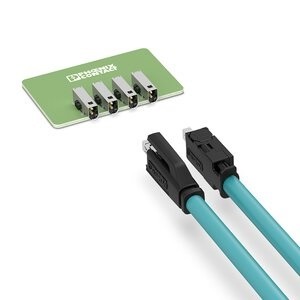
A network lead contains eight wires that are color-coded. Each pair of wires has a common theme and is twisted into four pairs. These twists are used to reduce interference and noise.
You can also wire your own leads. These are easy to do. Many people don't realize that they can wire their own connectors and leads. This project can be done at home if you are familiar with the basics of Ethernet cables, the different types of plugs and jacks, and how to use a few small tools.Ethernet Connectors
You can easily find the materials required to build an Ethernet cable at any of many electrical stores, home centers, or computer shops. Once you have all the necessary tools and supplies, you can start wiring your lead.
To achieve optimal performance, it is essential to use standard wiring procedures. There are many options for wiring but the most common is straight-through. These modular connectors, called RJ45 plugs, are available in 8 positions and have a similar appearance to a widened telephone plug. There are many styles available, so it is important to know which one you will use.
1 note
·
View note
Text
The New Basis of Industrial Connectivity and Networking Solutions
With the Industrial Internet of Things fast becoming the norm in industries, converging IT and OT technologies securely—a cornerstone of the IIoT—is still the Achilles heel for many companies. Thus, choosing the right industrial network solutions for your operation, and this cannot be repeated often enough, is essential. At the same time, this is easier said than done. Too often, this arduous task befalls an IT engineer with little experience of OT protocols and automation systems, or, on the flip side, an OT engineer with no knowledge of enterprise IT networking. In this article, we take a closer look at how new technologies are shaping the role of industrial connectivity and networking solutions in your IIoT applications.
Industrial Connectivity Needs—Now and in the Future
Connecting your previously unconnected industrial devices and assets is the first step to enabling IIoT applications. Accomplishing this task requires a thorough assessment of the types of OT assets you need to connect as well as the specific connectivity requirements, such as connecting OT assets to a local network or a cloud server. Since OT assets in industrial applications mainly use serial or I/O communication interfaces, choosing the right serial and I/O connectivity solutions is essential to enable industrial connectivity. Moreover, you need to keep in mind additional considerations, such as cybersecurity and large-scale device management, when connecting OT assets to remote or cloud servers.
Besides enabling connectivity for previously unconnected OT assets, connecting all of these field devices also requires building a network that can support information flows among multiple interconnected devices, systems, and even remote sites.
Suitable Solutions
With more than thirty years of experience in helping customers overcome industrial connectivity and networking challenges, we have identified several key criteria for selecting the most suitable solutions for industrial automation applications. Download our E-book where you can find considerations for each specific connectivity and networking solution you are looking for.
Before we come to the comparison between inline couplers and keystone jacks, let’s have a brief overview of these two jacks. A small device for connecting two ethernet cables to make a longer cable, usually called an inline coupler or RJ45 coupler. Inline couplers do not provide any amplification or signal boost, and can cause attenuation and signal degradation unless they are of high quality. There are cat5e and cat6 RJ45 inline couplers available on the market.
People who have electrical cable installation experience know clearly what is a keystone jack. A keystone jack is a female connector for mounting a variety of low-voltage electrical jacks or optical connectors into a keystone wall plate, faceplate, surface-mount box or patch panel. A keystone plug is a matching male connector, usually attached to the end of a cable or cord. Traditional keystone jack needs a punch-down tool to help finish cable installation, but this toolless STP keystone jack is different. With the snap-fit cap design, conductors can be terminated simultaneously when the cap is pressed into place, allowing for a simple installation without the need for a punch-down tool.
The eight-position modular plug uses insulation displacement contacts that terminate the conductors and provide the contact interface surface for the mating jack contacts. These plugs are crimp-terminated onto cordage or cable. With these new technologies, we are witnessing the conversion of many commercial building devices and systems from analog, to digital, and now IP-addressable. The resulting migration of these devices and systems to four-twisted-pair cabling represents an additional class of equipment looking to be served by versions of communication cabling.
A network wall plate is a cabling fixture attached to a wall in a work area for connecting computers to the network. Also called a faceplate. Wall Plates can have RJ-45 jacks for 10BaseT networks (which resemble household RJ-11 telephone wall jacks), BNC jacks for 10Base2 networks, or SC jacks for networks that use fiber-optic cabling. The back end of the connector joins a horizontal cable that runs inside the wall or through a false ceiling or floor to a patch panel in the wiring closet for that floor. Computers are then connected to the wall plate by a short unshielded twisted-pair (UTP) cable called a drop cable. Wallplates typically come in mono-port, dual-port, and quad-port configurations.
0 notes
